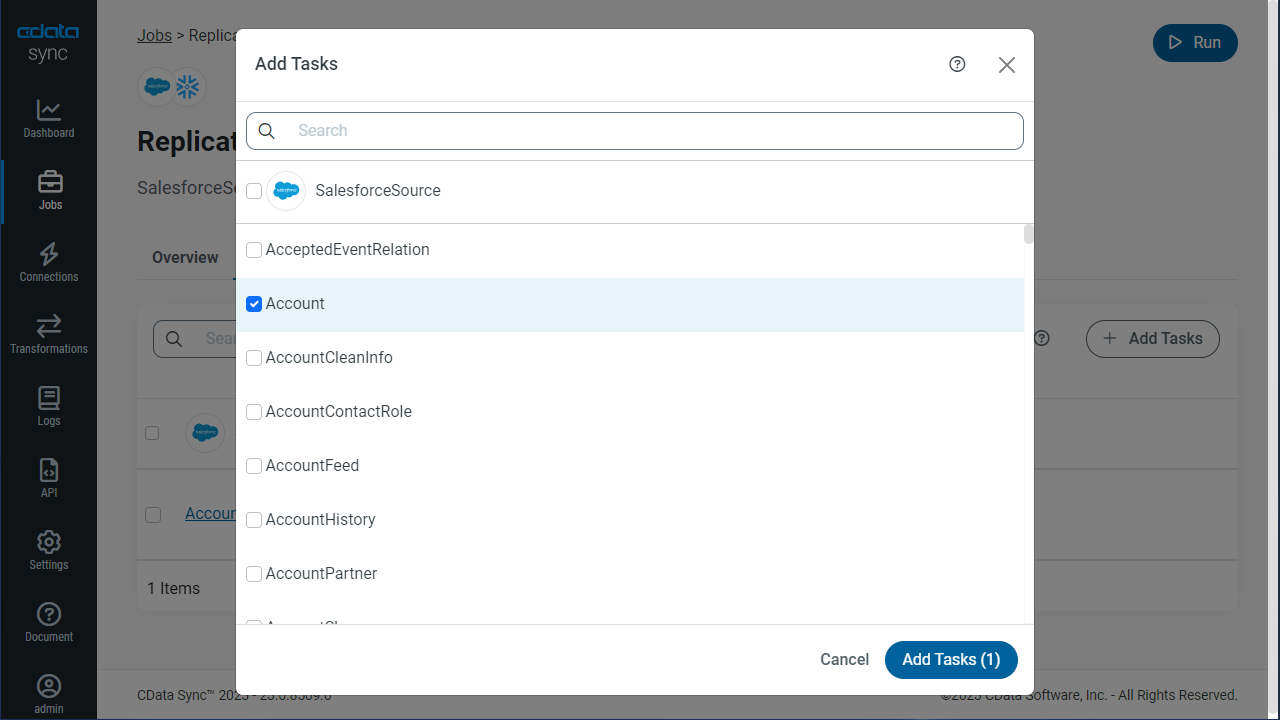Discover how a bimodal integration strategy can address the major data management challenges facing your organization today.
Get the Report →Automated Continuous HCL Domino Replication to Google BigQuery
Use CData Sync for automated, continuous, customizable HCL Domino replication to Google BigQuery.
Always-on applications rely on automatic failover capabilities and real-time data access. CData Sync integrates live HCL Domino data into your Google BigQuery instance, allowing you to consolidate all of your data into a single location for archiving, reporting, analytics, machine learning, artificial intelligence and more.
Configure Google BigQuery as a Replication Destination
Using CData Sync, you can replicate HCL Domino data to Google BigQuery. To add a replication destination, navigate to the Connections tab.
- Click Add Connection.
- Select Google BigQuery as a destination.
![Configure a Destination connection to Google BigQuery.]()
Enter the necessary connection properties. To connect to Google BigQuery, use OAuth authentication:
Authenticate with a User Account
In this OAuth flow, you can connect without setting any connection properties for your user credentials.
- Click Connect, and CData Sync opens the Google BigQuery OAuth endpoint.
- Log in and grant permissions to CData Sync.
- CData Sync then completes the OAuth process.
Authenticate with a Service Account
Service accounts have silent authentication, without user authentication in the browser. You can also use a service account to delegate enterprise-wide access scopes to CData Sync.
You need to create an OAuth application in this flow. See Creating a Custom OAuth App in the Getting Started section to create and authorize an app. You can then connect to Google BigQuery data that the service account has permission to access.
After setting the following connection properties, you are ready to connect:
- OAuthClientId: Set this to the Client ID in your app settings.
- OAuthClientSecret: Set this to the Client Secret in your app settings.
- OAuthJWTCertType: Set this to "PEMKEY_FILE".
- OAuthJWTCert: Set this to the path to the .pem file you generated.
- OAuthJWTCertPassword: Set this to the password of the .pem file.
- OAuthJWTCertSubject: Set this to "*" to pick the first certificate in the certificate store.
- OAuthJWTSubject: Set this to the email address of the user for whom the application is requesting delegate access. Note that delegate access must be granted by an administrator.
- DatasetId: Set this to the ID of the dataset you want to connect to.
- ProjectId: Set this to the ID of the project you want to connect to.
- Click Test Connection to ensure that the connection is configured properly.
![Configure a Destination connection.]()
- Click Save Changes.
Configure the HCL Domino Connection
You can configure a connection to HCL Domino from the Connections tab. To add a connection to your HCL Domino account, navigate to the Connections tab.
- Click Add Connection.
- Select a source (HCL Domino).
- Configure the connection properties.
Connecting to Domino
To connect to Domino data, set the following properties:
- URL: The host name or IP of the server hosting the Domino database. Include the port of the server hosting the Domino database. For example: http://sampleserver:1234/
- DatabaseScope: The name of a scope in the Domino Web UI. The driver exposes forms and views for the schema governed by the specified scope. In the Domino Admin UI, select the Scopes menu in the sidebar. Set this property to the name of an existing scope.
Authenticating with Domino
Domino supports authenticating via login credentials or an Azure Active Directory OAuth application:
Login Credentials
To authenticate with login credentials, set the following properties:
- AuthScheme: Set this to "OAuthPassword"
- User: The username of the authenticating Domino user
- Password: The password associated with the authenticating Domino user
The driver uses the login credentials to automatically perform an OAuth token exchange.
AzureAD
This authentication method uses Azure Active Directory as an IdP to obtain a JWT token. You need to create a custom OAuth application in Azure Active Directory and configure it as an IdP. To do so, follow the instructions in the Help documentation. Then set the following properties:
- AuthScheme: Set this to "AzureAD"
- InitiateOAuth: Set this to GETANDREFRESH. You can use InitiateOAuth to avoid repeating the OAuth exchange and manually setting the OAuthAccessToken.
- OAuthClientId: The Client ID obtained when setting up the custom OAuth application.
- OAuthClientSecret: The Client secret obtained when setting up the custom OAuth application.
- CallbackURL: The redirect URI defined when you registered your app. For example: https://localhost:33333
- AzureTenant: The Microsoft Online tenant being used to access data. Supply either a value in the form companyname.microsoft.com or the tenant ID.
The tenant ID is the same as the directory ID shown in the Azure Portal's Azure Active Directory > Properties page.
![Configure a Source connection (Salesforce is shown).]()
- Click Connect to ensure that the connection is configured properly.
- Click Save Changes.
Configure Replication Queries
CData Sync enables you to control replication with a point-and-click interface and with SQL queries. For each replication you wish to configure, navigate to the Jobs tab and click Add Job. Select the Source and Destination for your replication.

Replicate Entire Tables
To replicate an entire table, click Add Tables in the Tables section, choose the table(s) you wish to replicate, and click Add Selected Tables.

Customize Your Replication
You can use the Columns and Query tabs of a task to customize your replication. The Columns tab allows you to specify which columns to replicate, rename the columns at the destination, and even perform operations on the source data before replicating. The Query tab allows you to add filters, grouping, and sorting to the replication.
Schedule Your Replication
In the Schedule section, you can schedule a job to run automatically, configuring the job to run after specified intervals ranging from once every 10 minutes to once every month.

Once you have configured the replication job, click Save Changes. You can configure any number of jobs to manage the replication of your HCL Domino data to Google BigQuery.









